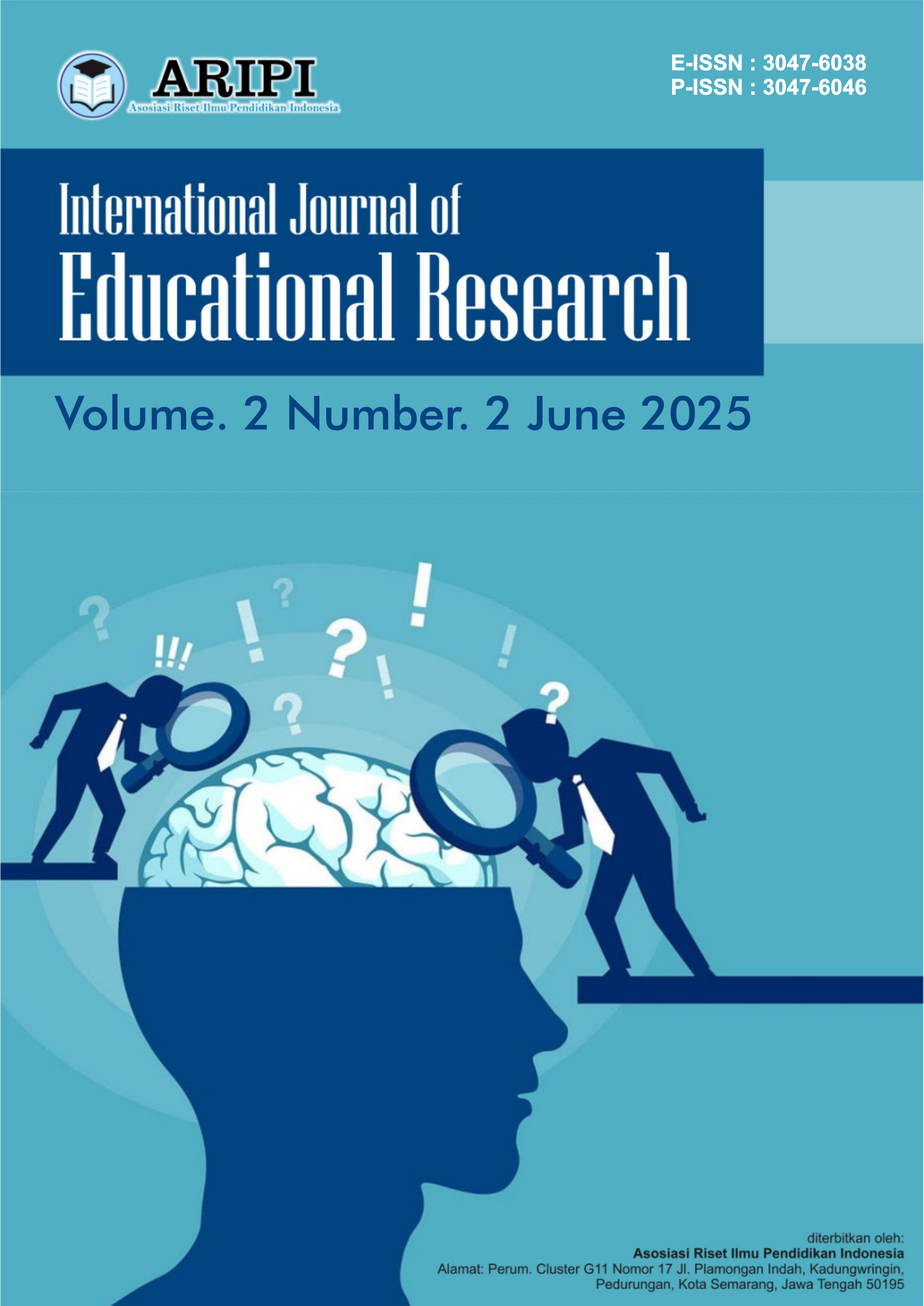Intonation and Articulation: An Early Childhood Vocalization Method
DOI:
https://doi.org/10.62951/ijer.v2i2.322Keywords:
Vocalizing, intonation, articulation, early childhood, musicAbstract
This study aims to analyze the role of the vocalization method in improving intonation and articulation skills in early childhood. Vocalization as form of singing training is one form of training that is considered effective for use at all ages. This research uses a qualitative method with a case study approach. The case study was conducted at Pre-School X with two vocal teachers. The result show that the vocalization method creates a very significant effect in improving intonation and articulation skills because this method gives freedom and feels fun for early childhood. On the other hand, this method also succeeds in improving children’s focus when learning intonation and articulation because they do not have to divide their attention with foreign meanings and words. Therefore, the study successfully showed that the vocalization method is very effective in improving intonation and articulation skills in early childhood.
References
R. P. Rijkiyani, S. Syarifuddin, and N. Mauizdati, “The Role of Parents in Developing Children’s Potential during the Golden Age,” Basicedu J., vol. 6, no. 3, pp. 4905–4912, Apr. 2022, doi: 10.31004/basicedu.v6i3.2986.
A. Buyalskaya, M. Gallo, and C. F. Camerer, “The golden age of social science,” Proc. Natl. Acad. Sci., vol. 118, no. 5, Feb. 2021, doi: 10.1073/pnas.2002923118.
M. Fransisca and A. Chris, “The relationship between stress levels in groups of individuals who sing regularly and do not sing,” Tarumanagara Med. J., vol. 2, no. 2, pp. 354–359, Oct. 2020, doi: 10.24912/tmj.v3i1.9741.
A. Aulia, Diana, and D. Setiawan, “The Importance of Music Learning for Early Childhood,” J. Golden Age, vol. 6, no. 1, 2022.
J. Kastanja and S. Watini, “Implementation of the Fun Singing Method in Increasing the Self-Confidence of Children in Group A1 of TK Negeri Pembina Nasional,” JIIP - Sci. J. Educ. Sci., vol. 5, no. 7, pp. 2636–2639, Jul. 2022, doi: 10.54371/jiip.v5i7.735.
C. I. Ichwan and D. N. Saputra, “Singing Activity as Indonesian Language Learning Media in Cianjur Bible School,” Tonika J. Arts Res. Stud., vol. 5, no. 2, pp. 132–146, Nov. 2022, doi: 10.37368/tonika.v5i2.476.
N. S. Kasih and Yensharti, “Application of Tone Ladder and Interval Materials to Strengthen Intonation in Singing the Song Yamko Rambe Yamko in the Implementation of Choir Extracurricular at SMP Negeri 29 Padang,” AVANT-GARDE Sci. J. Perform. Arts Educ., vol. 1, no. 2, pp. 107–114, May 2023, doi: 10.24036/ag.v1i2.12.
L. Irawati, D. P. Widiati, W. Emiliana, E. A. Sari, and S. Watini, “Implementation of SIUUL Model in improving Articulation Accuracy of Children with Speech Delay,” JIIP - Sci. J. Educ. Sci., vol. 6, no. 11, pp. 8534–8542, Nov. 2023, doi: 10.54371/jiip.v6i11.2655.
Z. I. Setyawati and S. Yanuartuti, “Vocal Learning Strategies for Children at Purwacaraka Music Studio Margorejo Surabaya,” J. Sendratasik Educ., vol. 10, no. 1, pp. 1–14, Dec. 2020, doi: 10.26740/jps.v10n1.p1-14.
R. Anita and A. Fitriyono, “Vocal Learning for Early Childhood with Confusy Technique,” Reebat J., vol. 1, no. 1, 2023.
Z. A. Widiastuti, “Problem-based Vocal Learning in Early Childhood at Tirando Music Education Surabaya,” Edu-Kata, vol. 9, no. 2, pp. 122–137, Aug. 2023, doi: 10.52166/kata.v9i2.4739.
B. A. Kusuma, “Vocalizing Humming and Lip Trill Methods to Train Choir Vocal Techniques at Smp Negeri 42 Surabaya,” J. Gener. Nusant. Educ., vol. 2, no. 2, 2024.
A. Alawiyah, N. Tisnawati, and L. Marlisa, “Analysis of the Relationship between Storytelling Method and Early Childhood Learning Concentration,” Thufulah Student Sci. J., vol. 1, no. 2, pp. 1–5, Aug. 2022, doi: 10.24127/thufulah.v1i2.3466.
D. G. A. Hutagalung and W. P. Tangkin, “Application of the Singing Method as an Effort to Develop Early Childhood Learning Concentration,” Indones. J. Early Child. World J. Early Child., vol. 5, no. 1, pp. 111–119, Jan. 2023, doi: 10.35473/ijec.v5i1.2035.
Sugiyono, Quantitative, Qualitative and R&D Research Methods. Alfabeta, 2023.
& H. Miles, M. B., Qualitative data analysis: A methods sourcebook, 3rd ed. SAGE Publications, 2014.
I. E. Lupita and T. W. Widodo, “Vocalizing technique to improve singing intonation of 12-year-old children at GIA Puri Anjasmoro Semarang,” IDEA Sci. J. Perform. Arts, vol. 18, no. 1, pp. 72–82, 2024.
K. P. Putri, H. Hartono, and Y. Gusanti, “Application of the Creative Vocalizing Method to Improve Singing Skills in Junior High School Choir Extracurricular,” JoLLA J. Lang. Lit. Arts, vol. 3, no. 6, pp. 790–803, Jun. 2023, doi: 10.17977/um064v3i62023p790-803.
C. D. Hartanti and H. Sasongko, “Creativity Management of Music Teaching in Early Childhood Education during the Covid 19 Pandemic,” Indones. J. Early Child. World J. Early Child., vol. 3, no. 1, p. 16, Feb. 2021, doi: 10.35473/ijec.v3i1.830.
E. Bonita, E. Suryana, M. I. Hamdani, and K. Harto, “The Golden Age: Early Childhood Development and its Implications for Islamic Education,” Tarb. Sci. J. Educ., vol. 6, no. 2, p. 218, Dec. 2022, doi: 10.32332/tarbawiyah.v6i2.5537.
S. Susandro and A. H, “Daniel Day-Lewis: A Psycho-physical Actor Who Brings Characters to Life Through Voice and Accent,” J. Art Stud., vol. 9, no. 2, p. 194, Apr. 2023, doi: 10.22146/jksks.75148.
M. Failashofa and A. Nur Fitria, “The Role of Parents in Stimulating Children’s Language Development in Paud Islam Makarima Kartasura District, Sukoharjo Regency,” PAUDIA J. Res. F. Early Child. Educ., vol. 11, no. 1, pp. 473–490, Jun. 2022, doi: 10.26877/paudia.v11i1.11699.
R. Rasto, I. Muhammad, F. A. Triansyah, and S. Maharani, “Bibliometric Analysis: Management in Early Childhood Education,” J. Obs. J. Pendidik. Anak Usia Dini, vol. 7, no. 5, pp. 6233–6248, Nov. 2023, doi: 10.31004/obsesi.v7i5.5387.
E. L. Laily, “Increasing the Self-Confidence of 5-6 Years Old Children through Singing Method,” 2022.
Downloads
Published
How to Cite
Issue
Section
License
Copyright (c) 2025 International Journal of Educational Research

This work is licensed under a Creative Commons Attribution-ShareAlike 4.0 International License.




